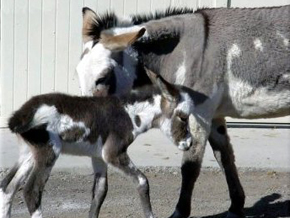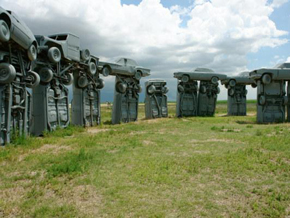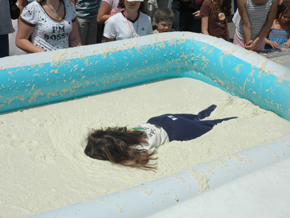Explore Small-Town USA

Whether it's the "troll capital of the world" or home to a national grits festival, every town has a story. They might be small, but they each have something unique about them, something that puts them on the map, something residents are known to brag about (and justly so). Explore and celebrate small-town USA.
Oatman, Arizona
Wild burros, or Spanish donkeys, still roam the streets in Oatman, Arizona, and the residents wouldn't have it any other way. Located across the Colorado River and up the hill from Laughlin, Nevada, Oatman is an authentic western ghost town and mining camp founded in the early 1900s after prospectors struck gold.
Though Oatman's current population of 150 is a far cry from the nearly 4,000 who once called it home, it has remained prosperous, and its residents take pride in keeping the town as authentic as possible.
Oatman's wild burros and gunshots at high noon are the biggest draw for the nearly 500,000 tourists who visit each year.
The Wild West–style shoot-outs that are performed daily take place in the heart of Main Street. Visitors are treated to a show that begins by the unmistakable sound of a double-barrel shotgun.
Another unmistakable tradition in Oatman is the annual sidewalk egg fry. Every Fourth of July at noon, the entire town gathers on Main Street for the unconventional cooking contest. Contestants have 15 minutes to fry the best breakfast using just two eggs and a piece of tinfoil. They can use any type of solar heat, mirror, or magnifying glass, but with summer temperatures often reaching well above 100 degrees, the pavement often does the trick, heating up just like an oven.
Despite the hundreds of thousands who visit Oatman each year, residents say they live very laid-back lives. "The stores open at 10 a.m. and close at 5 p.m., and if you're out after 5, we [might] run your toes over in the road," says Jerry Love, who has lived in Oatman for 21 years.
Love doesn't think Oatman is a tourist trap, but rather a place for folks to step back into history and learn about the richness of the land. "What you see is what you get," Love says. "And we are damn proud of it."
Discover the Corn Palace of Mitchell, South Dakota

Mitchell, South Dakota
Its 16,000 residents might make it seem big city compared to Oatman's 150, but Mitchell, South Dakota, is still the type of Midwest community where residents leave their front doors open for the neighbors, share their keys and watch each other's pets.
Although Mitchell prides itself on maintaining these tenets of small-town life, its claim to fame is a treasure that would seem better suited to the far-off lands of Europe—a palace.
The Corn Palace, as it's known, has been attracting millions of visitors since opening in the early 1900s. Murals made entirely of corn line the exterior of the palace, and the artists who design them call it a "corn-by-numbers game." To get the desired design, about 275,000 ears of corn are sawed in half, nailed flat-side to the building, and shaped according to a yearly theme. The process culminates with a festival featuring the best of the town's music, food and crops.
Hannah Walters is the director of Mitchell's convention and visitor's bureau and says the Corn Palace's tourism draw is a big boost to the town's economy and also to its residents' quality of life. "We get to offer fun events and festivals to our own community members; [they] get to enjoy all of these things," Walters says.
Beyond the Corn Palace, Walters says the community of 16,000 comes alive on Main Street, where residents can enjoy antique and gift shops, art galleries and restaurants. Mitchell also is home to the George McGovern Legacy Museum and Mitchell's Prehistoric Indian Village. Many residents say they also enjoy swimming, fishing and spending time at Lake Mitchell.
Visit the midwestern town known as the troll capitol of the world
Its 16,000 residents might make it seem big city compared to Oatman's 150, but Mitchell, South Dakota, is still the type of Midwest community where residents leave their front doors open for the neighbors, share their keys and watch each other's pets.
Although Mitchell prides itself on maintaining these tenets of small-town life, its claim to fame is a treasure that would seem better suited to the far-off lands of Europe—a palace.
The Corn Palace, as it's known, has been attracting millions of visitors since opening in the early 1900s. Murals made entirely of corn line the exterior of the palace, and the artists who design them call it a "corn-by-numbers game." To get the desired design, about 275,000 ears of corn are sawed in half, nailed flat-side to the building, and shaped according to a yearly theme. The process culminates with a festival featuring the best of the town's music, food and crops.
Hannah Walters is the director of Mitchell's convention and visitor's bureau and says the Corn Palace's tourism draw is a big boost to the town's economy and also to its residents' quality of life. "We get to offer fun events and festivals to our own community members; [they] get to enjoy all of these things," Walters says.
Beyond the Corn Palace, Walters says the community of 16,000 comes alive on Main Street, where residents can enjoy antique and gift shops, art galleries and restaurants. Mitchell also is home to the George McGovern Legacy Museum and Mitchell's Prehistoric Indian Village. Many residents say they also enjoy swimming, fishing and spending time at Lake Mitchell.
Visit the midwestern town known as the troll capitol of the world

The Peddler © 1990 Woodcarving by Michael J. Feeney
Mount Horeb, Wisconsin
From a Main Street lined with life-size trolls carved out of tree trunks to its rich Norwegian influence, Mount Horeb, Wisconsin truly lives up to its name as the Troll Capital of the World. The community of 7,000 is located just outside of Madison, Wisconsin, and locals say it's the kind of place where people wave and honk hello, even to strangers.
Chamber of Commerce executive director Melissa Theisen says that troll love in Mount Horeb began when a store in town started displaying imported Norwegian troll figurines outside of the store. Truck drivers passing by would radio to the other drivers and say, "I saw your mother and sister on the side of the road!" She says the town actually began to embrace the figurines. Today, there are 17 troll carvings throughout the town, troll merchandise in many of the stores and a main road was even nicknamed ''The Trollway."
Mount Horeb's original settlers were Scandinavian, and Theisen says that history is kept alive in banners and buildings detailing the area's roots.
Many of today's residents and visitors enjoy world-class biking along the 39-mile Military Ridge State Trail, which runs through the heart of Mount Horeb and offers scenic views of the town. Adventure enthusiasts also have close access to Tyrol Basin, which offers some of the Midwest's best skiing and snowboarding opportunities.
Whether it's because of the area's small-town charm or it's unique traditions, more than 200,000 tourists visit Mount Horeb each year, and the town has no plans to slow down its growth.
Learn why Carhenge put Allience, Nebraska on the map
From a Main Street lined with life-size trolls carved out of tree trunks to its rich Norwegian influence, Mount Horeb, Wisconsin truly lives up to its name as the Troll Capital of the World. The community of 7,000 is located just outside of Madison, Wisconsin, and locals say it's the kind of place where people wave and honk hello, even to strangers.
Chamber of Commerce executive director Melissa Theisen says that troll love in Mount Horeb began when a store in town started displaying imported Norwegian troll figurines outside of the store. Truck drivers passing by would radio to the other drivers and say, "I saw your mother and sister on the side of the road!" She says the town actually began to embrace the figurines. Today, there are 17 troll carvings throughout the town, troll merchandise in many of the stores and a main road was even nicknamed ''The Trollway."
Mount Horeb's original settlers were Scandinavian, and Theisen says that history is kept alive in banners and buildings detailing the area's roots.
Many of today's residents and visitors enjoy world-class biking along the 39-mile Military Ridge State Trail, which runs through the heart of Mount Horeb and offers scenic views of the town. Adventure enthusiasts also have close access to Tyrol Basin, which offers some of the Midwest's best skiing and snowboarding opportunities.
Whether it's because of the area's small-town charm or it's unique traditions, more than 200,000 tourists visit Mount Horeb each year, and the town has no plans to slow down its growth.
Learn why Carhenge put Allience, Nebraska on the map

Alliance, Nebraska
Deep in the middle of the Nebraska panhandle lies the town of Alliance, Nebraska. Residents say it's the kind of place where you can go outside on your front porch and actually see the stars and where, when in the midst of a challenge, everyone pulls together.
Dixie Nelson, lifelong Alliance resident and executive director for the chamber of commerce, says Alliance is the perfect place to live and raise a family. "How many places can you have a 10-year-old child [that] can walk or bike somewhere to their baseball game? That is what small-town America is about."
Alliance's most famous landmark is Carhenge,a replica of England's Stonehenge. In place of Stonehenge's rocks, Carhenge's architects used 38 vintage American automobiles.
This one-of-a-kind structure was conceived in 1987 by former resident Jim Reinders as a memorial to his father. Reinders had traveled extensively throughout the world and spent a lot of time in England studying Stonehenge. He collected cars from the area surrounding Alliance and, over a period of days, erected Carhenge. Nelson jokes that the project "took a lot of blood, sweat and beers."
It's estimated that about 80,000 people a year visit the attraction, which is included in the book 1000 Places to See in the USA and Canada Before You Die and was the subject of the 2005 documentary Carhenge: Genius or Junk?
Discover St. George, South Carolina, grits capitol of the world
Deep in the middle of the Nebraska panhandle lies the town of Alliance, Nebraska. Residents say it's the kind of place where you can go outside on your front porch and actually see the stars and where, when in the midst of a challenge, everyone pulls together.
Dixie Nelson, lifelong Alliance resident and executive director for the chamber of commerce, says Alliance is the perfect place to live and raise a family. "How many places can you have a 10-year-old child [that] can walk or bike somewhere to their baseball game? That is what small-town America is about."
Alliance's most famous landmark is Carhenge,a replica of England's Stonehenge. In place of Stonehenge's rocks, Carhenge's architects used 38 vintage American automobiles.
This one-of-a-kind structure was conceived in 1987 by former resident Jim Reinders as a memorial to his father. Reinders had traveled extensively throughout the world and spent a lot of time in England studying Stonehenge. He collected cars from the area surrounding Alliance and, over a period of days, erected Carhenge. Nelson jokes that the project "took a lot of blood, sweat and beers."
It's estimated that about 80,000 people a year visit the attraction, which is included in the book 1000 Places to See in the USA and Canada Before You Die and was the subject of the 2005 documentary Carhenge: Genius or Junk?
Discover St. George, South Carolina, grits capitol of the world

St. George, South Carolina
St. George, South Carolina, touts itself as the Grits Capital of the World. The 2.500 residents of the small farm community consume more grits per capita than any other place in the world. To pay tribute to this claim, the town celebrates with its annual World Grits Festival.
Now entering its 25th year, the World Grits Festival attracts the entire town and tens of thousands of visitors, all of whom gather in St. George's town square to eat, buy and even roll themselves in grits. Lifelong resident Roger Myers is the chairman for the festival and says the rolling contest has become a crowd favorite. "[We] weigh you before you go into the grits, and then [we] weigh you when you leave,"he says. "Whoever picked up the most weight [in grits] wins."
Myers says the town truly does live up to its grits reputation and that some eat it every day. "People like white or yellow grits and [have it] normally for breakfast. ... Some put ketchup,eggs, milk or butter in it."
St. George locals say they have embraced the culture of their town and love meeting tourists from around the country. Residents also pride themselves on being a town full of friendly people. As is a part of the small town playbook, Myers says, everyone knows your name. "Everybody knows everybody's business pretty well— more than they need to sometimes."
Do you have a favorite small town? Leave your comment below.
St. George, South Carolina, touts itself as the Grits Capital of the World. The 2.500 residents of the small farm community consume more grits per capita than any other place in the world. To pay tribute to this claim, the town celebrates with its annual World Grits Festival.
Now entering its 25th year, the World Grits Festival attracts the entire town and tens of thousands of visitors, all of whom gather in St. George's town square to eat, buy and even roll themselves in grits. Lifelong resident Roger Myers is the chairman for the festival and says the rolling contest has become a crowd favorite. "[We] weigh you before you go into the grits, and then [we] weigh you when you leave,"he says. "Whoever picked up the most weight [in grits] wins."
Myers says the town truly does live up to its grits reputation and that some eat it every day. "People like white or yellow grits and [have it] normally for breakfast. ... Some put ketchup,eggs, milk or butter in it."
St. George locals say they have embraced the culture of their town and love meeting tourists from around the country. Residents also pride themselves on being a town full of friendly people. As is a part of the small town playbook, Myers says, everyone knows your name. "Everybody knows everybody's business pretty well— more than they need to sometimes."
Do you have a favorite small town? Leave your comment below.



